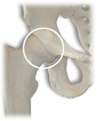Hip Arthrogram
Find your care
At the UCLA Health Spine Center, our experts diagnose, manage and treat all spinal injuries and conditions. Call 310-319-3475 to connect with a spine specialist.
Fax: 424-259-6560
Background
A physician considers a diagnostic block of a patient's hip because the diagnosis of hip arthritis or lumbar radiculopathy is not clear.
What Is It
Hip injection is a procedure that targets the joint where the leg joins the pelvis. A steroid medication is injected into the joint. To ensure proper placement of the medication, the procedure is done under fluoroscopy or x-ray.

Who Benefits
Hip injection is useful for patients with arthritis, hip, groin, buttock and/or leg pain.
Purpose
By placing a steroid medication into the joint it reduces the inflammation and thus may alleviate pain.
How Is It Done
While lying on the back on an x-ray table, the patient's skin will be cleansed and prepared. An x-ray is taken of the hip joint to know the EXACT location to place the medication. Then a needle will be inserted into the joint. An anesthetic and steroid medication are slowly injected into the area.
What to Expect
During the injection, pain will increase temporarily. Following the procedure, the patient may experience some initial discomfort for about two to three days. Once the medication reaches the inflamed area, the pain hopefully should be relieved.